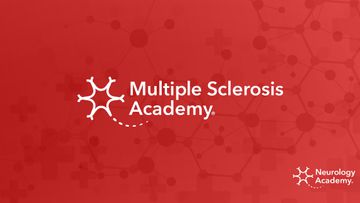Rehabilitation in MS: That was then, this is now: Patricia Bobryk, MHS PT MSCS, ATP
Event reportsNoreen Barker
Consultant MS nurse, University College London Hospitals NHS Foundation Trust
Aims of the session
The aims of this session are to:
- Recognise advancement in MS rehabilitation over the years
- Identify the need to translate recent research into current rehabilitation practice
- Understand the need for ongoing evidence to further advance practice patterns to maximise rehabilitation outcomes
That was then...
One of the first cases MS described was in St. Lidwina (1380-1433). Some of the symptoms described were:
- Loss of balance
- Facial pain
- Visual loss
- Progressive weakness
The first person for whom a definite diagnosis of MS can be made is Augustus d’Este (1794–1848), a grandson of King George III.
The distinct phases of MS described as him experiencing were:
- Paraplegia: passive or functional
- Organic form: progressive Disease progression
- Paraplexis: permanent damage, which is unrecoverable
Having tried the conventional treatment of the day, Augustus d’Este consulted in 1840 Vincent Priessnitz, the founder of hydrotherapy, who advocated suitable food, air, exercise, rest and water, which is consistent with the wellbeing with MS advocated today.
Uhthoff , a founder of neuro-ophthalmology, and Charcot, a French neurologist, both recognised that people living with MS (PwMS) experienced deterioration in visual acuity during physical exercise, and that MS symptoms are increased when temperature increases due to fever, hot meals, weather, menstruation, smoking or psychological stress. Because of a fear that activity would precipitate a worsening condition, the recommendation was that PwMS rest with no stressors. The ‘no smoking recommendation in MS was ahead of its time.
This is now...
The situation now is that several studies demonstrate the safety of exercise:
- Tallner et al (2011), in a study with 632 patients, demonstrated no significant difference in self-reported relapses over 2 years between the exercise/no exercise groups
- But Pilutti et al (2014), in a systematic review, showed that there was less chance of relapse in the exercise group
The benefits of exercise have been reported. For example, Petajan (1996) described studies of a 15-week programme of aerobic training and found:
- Increased maximum aerobic capacity
- Decreased skin fold thickness
- MS patients reap similar benefits from exercise to those without MS
- Exercise offsets difficulties in MS: fatigue, low mood, reduced quality of life (QOL)
Reynolds (2018) evaluated progressive resistance training (PRT) and found:
- Improved balance and functional ability
- Increased strength and muscle fibre size and power generated
High intensity interval training (HIIT) delivers similar outcomes to PRT, with increased strength and QoL noted within a shorter time frame.
We can change how we work with PwMS; exercise training is safe for MS, and PwMS should not be deterred for fear of relapse.
The following advice appears in the Canadian Physical Activity guidelines for Adults with MS (2020):
- Thirty minutes of aerobic exercise twice per week
- Strength training of all muscle groups twice per week, with weights if appropriate (10–15 repetitions/two sets/gradual increase)
- After 12–16 weeks this yields definite improvement in fitness, fatigue levels, QoL and mobility
In 2020, Kalb et al made Exercise and lifestyle recommendations for PwMS [1]:
- Early intervention by physical/occupational/sports therapist to establish an individual exercise plan, taking into account symptoms, fluctuations and comorbidities
Health care professionals should encourage at least 2.5 hours of exercise per week, which may be gardening, dancing or vigorous housework. Progress should be gradual, based on a person’s ability, preferences and safety.
HIIT is safe and efficacious, and better at inducing cardiorespiratory response in PwMS with mild disability. There is recumbent stepping-based HIIT exercise for PwMS with significant mobility problems (Expanded Disability Status Scale (EDSS) 4.0–6.5). The literature indicates benefits of exercise with progressive patients.
Studies on biomarkers have suggested benefits of exercise training:
- Regular exercise may have anti-inflammatory properties
- Brain connectivity may be increased in response to exercise
- It may improve cognitive function and motor skill acquisition
- Weight management in MS may enhance the effect of exercise training
- PRT may have a neuroprotective/neuro regenerative effect in relapsing-remitting MS (RRMS)
- Moderate intensity exercise for 2–3 sessions/week for at least 4 weeks can improve brain function and integrity
Exercise as complementary therapy
Exercise training could be considered as an important complementary therapy. Exercise prescription is important as a disease-modifying therapy (DMT). Previously, unidisciplinary care has moved through the interdisciplinary stage and is now multidisciplinary. However, the goal is a transdisciplinary model in order to treat the whole patient and work towards the same goals. To this effect a comprehensive team approach. Comprehensive care in MS (2010), a CMSC white paper has been produced, which is similar to the MS Trust’s Forward View (2016).
Up to 75% of people with MS experience pain, not all of which is MS-related, and which is poorly responsive to conventional medical management. It is now recognised that there are a number of pain syndromes in MS, better managed with:
- Targeted physical therapy
- Neuromodulation
- Medicinal cannabis (in some states of the US)
Some 43–67% of people with MS become unemployed within 12–15 years of diagnosis because of a combination of physical, cognitive and emotional symptoms [2].
The cognitive symptoms of MS were acknowledged as early as the 1800s, and are now widely recognised. Guidance published by CMSC and the National MS Society (2018) recognises increased professional and patient awareness, and describes the prevalence, impact and appropriate management of cognitive symptoms (Kalb, 2020). As a minimum, an early baseline, by symbol digit modalities test (SDMT), should be established. This should be reassessed annually or when:
- Acute activity is detected
- DMT is commenced or finished after relapse recovery
- Cognitive impairment has progressed
- New onset of cognitive problems occurs
Conclusion
The take home message of this session was:
Brain health is important. Diet and exercise are vital components of MS care and could be seen as a complementary therapy.
In summary, evidence from history and from modern studies supports exercise being beneficial for people with MS.
- It improves the management of fatigue, mobility, mood and QoL
- Regular exercise, diet and giving up smoking remain important for brain health and overall wellbeing
- Modern fitness regimes, such as HIIT or PRT, are beneficial for PwMS, and should not be discouraged
- PwMS should be assessed for an individualised exercise plan (from diagnosis)
- PwMS with more progressive disease can benefit from exercise, and it can be adapted
- Regular cognitive assessment is important
- Pain can be better managed
- PwMS should receive comprehensive care following a transdisciplinary model
- Employment and MS remains an issue; vocational rehabilitation is a vital component of rehabilitation in MS
References
- Tallner A, Waschbisch A, Wenny I et al. Multiple sclerosis relapses are not associated with exercise. Mult Scler J 2011; 18(2):232–235.
- Pilutti LA, Platta ME, Motl RW, Latimer-Cheung AE. The safety of exercise training in multiple sclerosis: a systematic review Journal Neurol Sci 2014 343:3-7
- Petajan P, Gappmaier E, White AT, Spencer MK, Mino L, Hicks RW, ‘Impact of aerobic training on fitness and quality of life in multiple sclerosis’, Annals of Neurology, April 1996
- Reynolds E, Ashbaugh A, Hockenberry B, McGrew C, ‘Multiple Sclerosis and Exercise: A Literature Review’, Current Sports Medicine Reports 17(1):31-35 · January 2018
- The Canadian Physical Activity Guidelines for adults with MS (2020)
- Comprehensive Care in MS (2010)
- MS Trust, ‘MS Forward View – A Consensus for the Future of MS Services’, 2016
- Kalb R, Brown T, Coote S et al. Exercise and lifestyle physical activity recommendations for people with multiple sclerosis throughout the disease course. Mult Scler J 2020; 1352458520915629.
- LaRocca N, Kalb R, Kendall P, Scheinberg L. The role of disease and demographic factors in the employment of patients with multiple sclerosis. Arch Neurol 1982; 39(4):256.
The full CMSC session is available to watch here via NeurologyLive.

This activity has been sponsored by Roche Products Limited. Roche Products Limited has had no control over the educational content of this activity.
Related articles
Encouraging excellence, developing leaders, inspiring change
MS Academy was established five years ago and in that time has accomplished a huge amount. The six different levels of specialist MS training are dedicated to case-based learning and practical application of cutting edge research. Home to national programme Raising the Bar and the fantastic workstream content it is producing, this is an exciting Academy to belong to.



